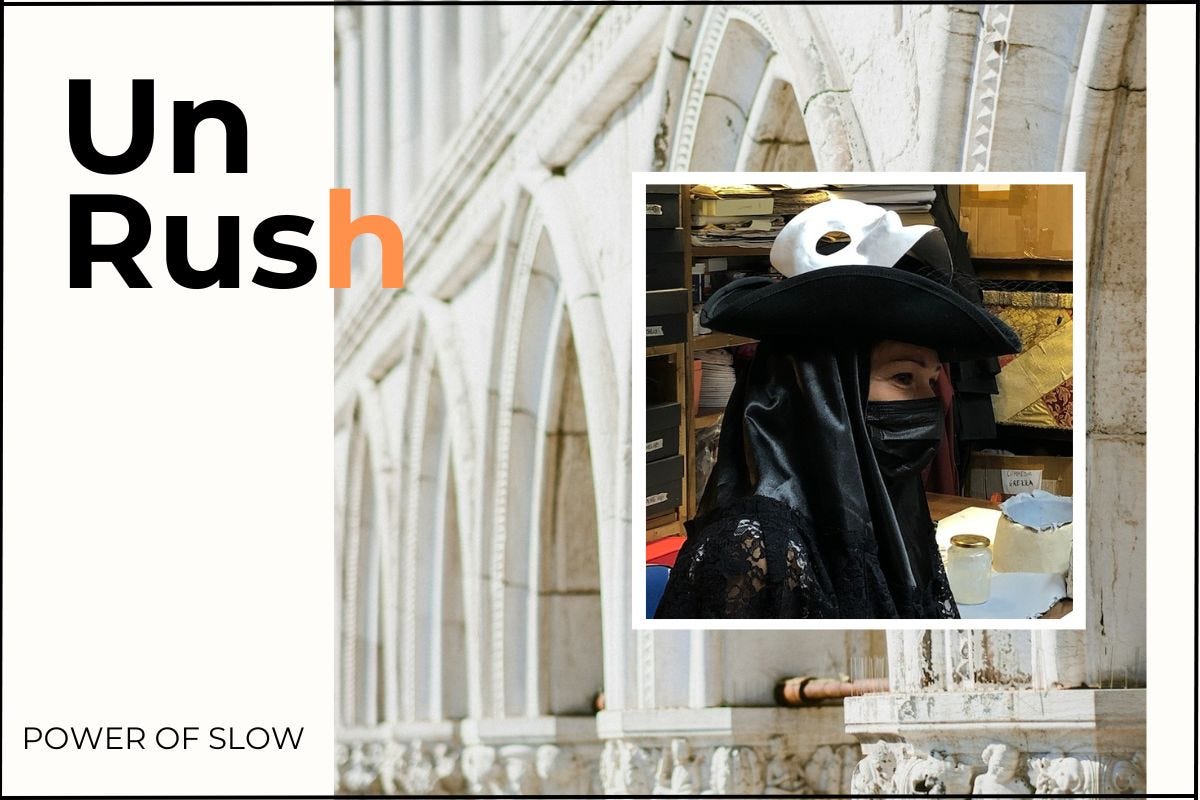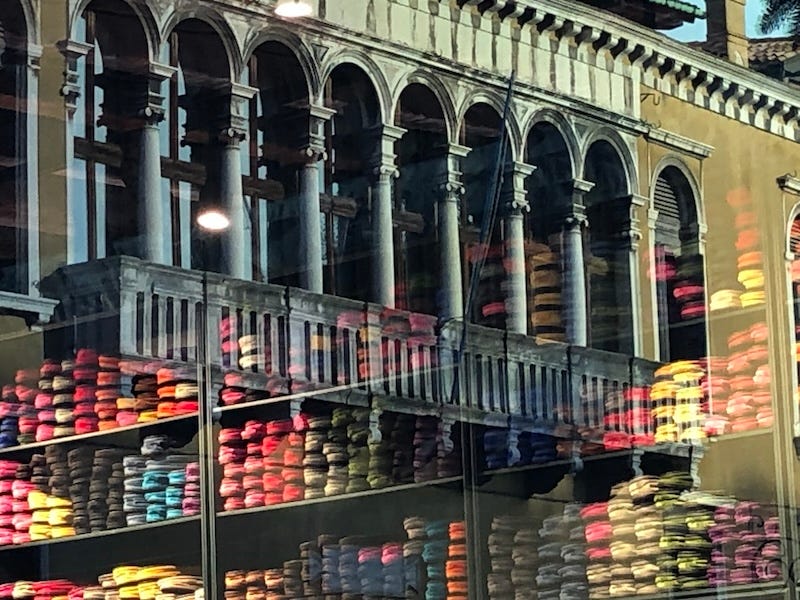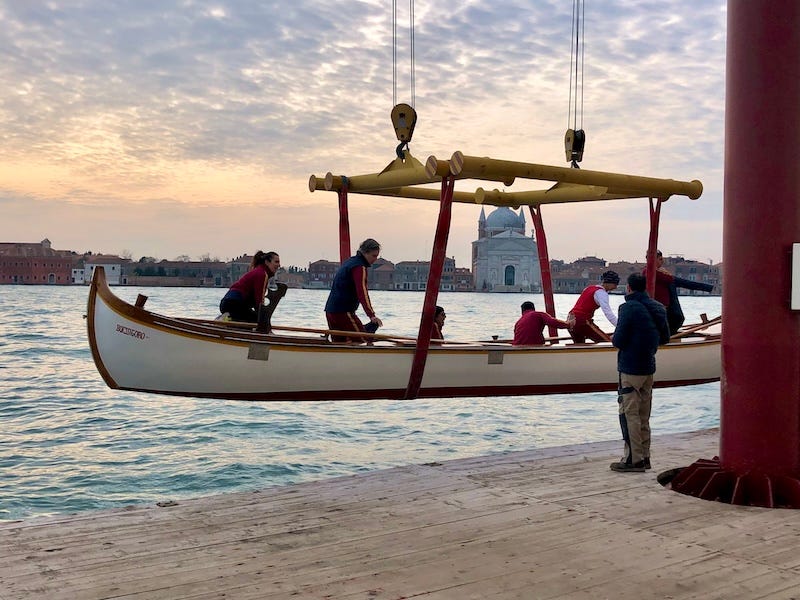Hello out there - in a rushed world looking for some sanity and serenity!
Here is some input for getting clarity and confidence to pursue the power of slow and to smile wearily at the absurdity of rushing.
If you enjoy reading this post from my Newsletter Un-Rush, feel free to share it with your friends and click the❤️ button, so more people can discover it on Substack. Thank you!
The Slow Death of Venice
And what to learn from it for Slow Travel
Francesca is a mask maker in Venice. Her father started the craft in the 1980s when the Carnival in Venice was brought back to life, and at the time, there were 12 mask makers. Since then, she has continued this craft with passion and fights for the survival of crafts and Venetian traditions. She is one of the few handcrafted mask makers among the many Chinese shops selling cheap, imported plastic masks (and other useless junk).
Years ago, we became friends with Francesca and her father, and we talked to her again in her shop last week and heard her stories. Her eyes are still sparkling with enthusiasm and passion, but her visions and hopes for the future of Venice and its traditions are crumbling.
Francesca initiated various activities during the Carnival season that celebrate and convey the history of the Venetian carnival, which goes back to the 12th century. Lately, the city government started installing more rules and bans, for example, for the historical, lively, and creative parade Francesca organized. No more parades. The rulers of the city are enthusiastic about getting more tourists into Venice, but less engaged in supporting Venetian traditions. Similar stories we heard from the last operating gondola building and repair shop in Venice.
So, why not turn Venice into an open-air museum? No kidding. We all wonder. Is Venice suffering a slow death? Not easy to judge. You are looking at a city that depends on tourism on one side and on city rulers on the other hand, who do not care about the cultural traditions of its city, for which the tourists come. They simply want tourists to show up and leave their money.
Venice has progressively lost its inhabitants. Less than 50,000 people reside in the historical city center, which was visited by almost six million tourists in 2023. Overtourism, with an enormous disproportion between visitors and inhabitants, has significantly lowered Venice’s life quality.
It is obviously hard to predict what will happen with this unique city. But we can use the travel destination Venice as an example of how to look at some aspects of slow travel in a location that is suffering from over-tourism.
What does slow travel mean?
Like slow food, the movement that originated the slow movement, slow traveling is a mindset that focuses more on quality instead of the number of experiences.
Slow travel is about going places and taking your time, caring about the place, and appreciating its history, people, and culture. It’s about ditching the must-sees and allowing yourself to smooth into the pace of the locals. It’s about finding the local foods, crafts, stories, and details in architecture and observing the daily life of the locals. You actually see and experience more by rushing less from spot to spot. Slow travel offers you the opportunity to immerse and connect.
Let’s take some lessons from my visit to Venice last week for SLOW TRAVEL
In Venice or any other crowded travel destination, you can embrace Slow Travel in a variety of ways:
Take your time and staying in a travel destination for a bit opens up the opportunity to discover local craftspeople, traditional shops, restaurants and bars where the locals go
Have the patience to learn about the history, culture, and traditions of a place
Sit in a café and just observe what is around you, who passes by
Try to befriend some locals, always go to the same café and connect with the people
Pick a topic that is typical for the location and go deeper to find out more about it than the quick reading of a few pages in a travel book
Get lost while walking around with no map and no schedule
Let go of THE things to see, instead, embrace the small local gems
Collect stories and lasting moments
Observe how daily life looks like for the people living in this particular place
Take art, cooking, and craft classes
We might not be able to save Venice, but we can cherish and show appreciation for this city’s traditions, history, and craft, instead of rushing with the masses through the alleys and canals. And perhaps that is a little support we can give.
Special Tips for Slow Travel in Venice:
Turn around the corner and enjoy the stillness.
It is easy in Venice to roam around quiet alleys, tiny bridges, and small piazzas. The crowds are mainly around St. Mark’s Square (Piazza San Marco). It doesn’t take much to get away from there, and as you can imagine, it is so much more relaxing to be away from the crowds.
Take the time to find the tradition.
There are still old crafts shops, where Venetians skillfully work with textiles, glass, paper mâché, pencils, paint, canvasses, wood, stone, and more. Get lost in those narrow aisles and alleys, and you will come across these places (or there are literature, articles, or books you can browse to find them. Or ask me for some tips).
Observe and recognize the normal in the unusual.
Venice is a city on the water. And it’s a working, functioning city. Everything we do on the streets happens there on the water: the ambulance is a boat, furniture is transported by boat to its new home, garbage collection travels on the water, DHL has delivery boats, and taxis speed through the canals. Normal life is different here. Take your time to observe it. Reflect on what daily life looks like when there are no cars, no bicycles, no trucks, and the arteries of a city are water canals and not streets.
Get lost in the details.
When you once start to notice all the details in the architecture of the buildings, in the wooden doors and their knobs, in the gondola designs, or on the bridges, you can get lost in discovering the endlessly interesting details in Venice.
Immerse and connect.
Send me a direct message if you like a list of 7 Venetian crafts/artisan shops I can recommend.











I love the idea of slow travel, Claudia. My husband and I have practiced this during our February trips to San Miguel de Allende, Mexico. It's wonderful not to drive for a month. To learn about regional history and art. To cook on a little gas stove and linger on a terrace. I have yet to see Italy, but hope to get there one day. Thanks for sharing your wisdom. ✍️🦋
Thanks for this! I'm still hoping to make a winter journey to Venice one day. Maybe my AT will meet me there? I'd love to have your list, se faz favor (practicing my European Portuguese!).